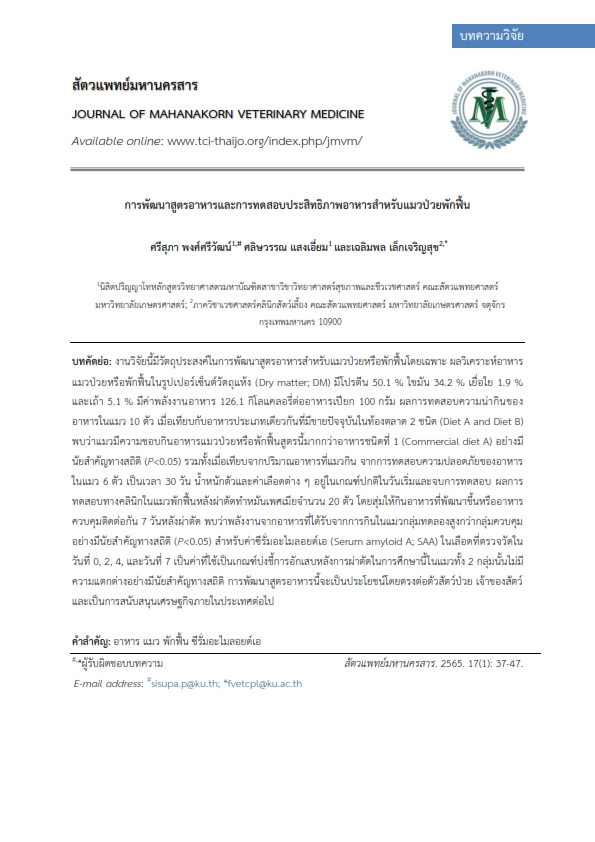Development of Dietary Formulation and Efficacy Test for Convalescent Cats
Main Article Content
Abstract
The objective of this research is to develop a diet formula specifically for convalescent cats. The proximate analysis as dry matter basis results of the convalescent cat diet formula contained 50.1% protein, 34.2% fat, 1.9% fiber and 5.1% ash, with a dietary energy value of 126.1 kcal per 100 g of diet. The palatability test in 10 cats had been compared to two commercially comparable diets currently available in the market (Diet A and Diet B). The result found that the cats significantly preferred the developed diet over the commercial diet A and also by weight of diet intake (P<0.05). The safety test was performed on 6 healthy cats for 30 days. It was found that the body weight and blood parameters were within the normal range on Day 0 and Day 30 of the test period. The clinical trial was implemented on 20 recovering female cats in 2 experimental groups for 7 days immediately after ovariohysterectomy (OVH) by randomly giving the assigned diet to them. The control group and the treatment group were given the maintenance diet and developed diet, respectively. It was found that the diet energy that cats received in the treatment group was statistically significant higher than in the control group (P<0.05). In this study, serum amyloid A (SAA) was used as the key indicator for postoperative inflammation. The SAA was measured on days 0, 2, 4, and 7. There was no statistically significant difference between 2 groups for SAA measurements. The developed diet will be directly beneficial to ill cats, cat owners, and support for Thailand economic in the near future.
Article Details

This work is licensed under a Creative Commons Attribution-NonCommercial-NoDerivatives 4.0 International License.
References
Bower, R. H., Cerra, F. B., Bershadsky, B., Licari, J. J., Hoyt, D. B., Jensen, G. L., Van Buren, C. T., Rothkopf, M. M., Daly, J. M., and Adelsberg, B. R. 1995. Early enteral feeding of a formula (Impact registered trademark) supplemented with arginine, nucleotides, and fish oil in intensive care unit patients: results of a multicenter, prospective, randomized, clinical trial. Critical Care Medicine. 35: 436-449.
Chambrier, C., and Sztark, F. 2012. French clinical guidelines on perioperative nutrition. Update of the 1994 consensus conference on perioperative artificial nutrition for elective surgery in adults. J. Visc. Surg. 149(5): e325-336.
Chung, C. K., Whitney, R., Thompson, C.M., Pham, T.N., Maier, R.V., and O'Keefe, G.E. 2013. Experience with an enteral-based nutritional support regimen in critically ill trauma patients. J. Am. Coll. Surg. 217(6): 1108-1117.
Delaney, S. J. 2006. Management of anorexia in dogs and cats. Vet. Clin. North Am. Small Anim. Pract. 36(6): 1243-1249, vi.
Desborough, J. P. 2000.). The stress response to trauma and surgery. Br. J. Anaesth. 85(1): 109-117.
Evoy, D., Lieberman, M. D., Fahey III T.J., and Daly, J.M. 1998. Immunonutrition: The role of arginine. Nutrition. 14: 611-617.
Giordano, A., Spagnolo, V., Colombo, A., and Paltrinieri, S. 2004. Changes in some acute phase protein and immunoglobulin concentrations in cats affected by feline infectious peritonitis or exposed to feline coronavirus infection. The Veterinary Journal. 167(1): 38-44.
Husby, G., Husebekk, A., Skogen, B., Sletten, K., Marhaug, G., Magnus, J., and Syversen, V. 1988. Serum amyloid A (SAA) the precursor of protein AA in secondary amyloidosis. Adv. Exp. Med. Biol. 243: 185-192.
Kajikawa, T., Furata, A., Onishi, T., Tajima, T., and Sugii, S. 1999. Changes in concentrations of serum amyloid A protein, alpha 1-acid glycoprotein, haptoglobin, and C-reactive protein in feline sera due to induced inflammation and surgery. Vet. Immunol. Immunopathol. 68: 91-98.
Kluve-Beckerman, B., Yamada, T., Hardwick, J., Lepnieks, J.J., and Benson, M.D. 1997. Differential plasma clearance of murine acute-phase serum amyloid A proteins SAA1 and SAA2. Biochem. J. 322: 663-669.
Larsen, J. A., and Perea, S.C. 2011. Enteral nutrition and tube feeding and parenteral nutrition. West Sussex: Blackwell.
Liu, D. T., Brown, D.C., and Silverstein, D.C. 2012. Early nutritional support is associated with decreased length of hospitalization in dogs with septic peritonitis: A retrospective study of 45 cases (2000-2009). J. Vet. Emerg. Crit. Care (San Antonio). 22(4): 453-459.
Prins, H. A., Houdijk, A.P., van. Lambalgen, A.A., Teerlink, T., Meijer, S., Thijs, L.G., and van. Leeuwen, P.A.M. 1998. Paradoxical changes in organ blood flow after arginase infusion in the non-stressed rat. Shock. 9: 422-427.
R Core Team. 2021. R: A language and environment for statistical computing. R Foundation for Statistical Computing, Vienna, Austria. URL https://www.R-project.org/.
Saker, K. E., and Remillard, R. L. 2010. Critical care nutrition and enteral-assisted feeding. In H. M.S. (Ed.), Small Animal Clinical Nutrition, 5th Edition (pp. 439-476). Topeka: Mark Morris Institute.
Sasaki, K., Ma, Z., Khatlani, T.S., Okuda, M., Inokuma, H., and Onishi, T. 2003. Evaluation of feline serum amyloid A (SAA) as an inflammatory marker. J. Ver. Med. Sci. 65: 545-548.
Schreiber, G., Howlett, G., Nagashima, M., Millership, A., Martin, H., Urban, J., and Kotler, L. 1982. The acute phase response of plasma protein synthesis during experimental inflammation. Biochemical Journal. 257: 10271-10277.


